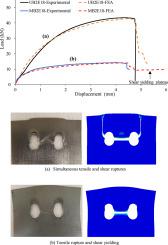当前位置:
X-MOL 学术
›
J. Constr. Steel Res.
›
论文详情
Our official English website, www.x-mol.net, welcomes your feedback! (Note: you will need to create a separate account there.)
Material ductility and temperature effects on block shear capacity of bolted connections
Journal of Constructional Steel Research ( IF 4.1 ) Pub Date : 2021-02-01 , DOI: 10.1016/j.jcsr.2020.106461 YongHyun Cho , Lip H. Teh , Aziz Ahmed , Ben Young
Journal of Constructional Steel Research ( IF 4.1 ) Pub Date : 2021-02-01 , DOI: 10.1016/j.jcsr.2020.106461 YongHyun Cho , Lip H. Teh , Aziz Ahmed , Ben Young

|
Abstract The block shear equation in the current Australasian and amended North American cold-formed steel design specifications is based on shear yielding without strain hardening, while that in the new Aluminum Design Manual assumes full shear strain hardening. This study investigates the range of applicability for both assumptions through experimental tests involving ultra-high strength steel bolted connections at room (ambient) and elevated temperatures, where the levels of material ductility are vastly different from each other. The experimental program has found that the block shear capacities of the ultra-high strength steel bolted connections at room temperature can be determined accurately by neglecting shear strain hardening, but full hardening can be assumed for high strength and mild steel connections. Surprisingly, at temperatures above 300 °C, even the assumption of full shear strain hardening for single-row bolted connections is too conservative, by up to 50%. Finite element analysis is used to show that the catenary effect increases with increasing temperature, as does the extent of shear strain hardening. Another finding is that a conventional block shear failure may occur by simultaneous tensile and shear ruptures, if the material ductility is low enough (rather than high enough as believed in the literature). Contrary to intuition, the block shear capacity of a bolted connection failing by simultaneous tensile and shear ruptures has to be computed using the shear yield stress rather than the shear ultimate stress.
中文翻译:

材料延展性和温度对螺栓连接块抗剪能力的影响
摘要 当前澳大拉西亚和修正后的北美冷弯型钢设计规范中的块剪切方程基于无应变硬化的剪切屈服,而新的铝设计手册中的假设完全剪切应变硬化。本研究通过涉及超高强度钢螺栓连接在室温(环境)和高温下的实验测试来调查这两种假设的适用范围,其中材料的延展性水平彼此大不相同。实验程序发现,室温下超高强度钢螺栓连接的块体剪切能力可以通过忽略剪切应变硬化来准确确定,但对于高强度和低碳钢连接可以假设完全硬化。出奇,在 300 °C 以上的温度下,即使假设单排螺栓连接的完全剪切应变硬化也过于保守,高达 50%。有限元分析用于表明悬链线效应随着温度的升高而增加,剪切应变硬化的程度也是如此。另一个发现是,如果材料延展性足够低(而不是文献中认为的足够高),则传统的块体剪切破坏可能会同时发生拉伸和剪切断裂。与直觉相反,由于同时发生拉伸和剪切断裂而失效的螺栓连接的块体剪切能力必须使用剪切屈服应力而不是剪切极限应力来计算。有限元分析用于表明悬链线效应随着温度的升高而增加,剪切应变硬化的程度也是如此。另一个发现是,如果材料延展性足够低(而不是文献中认为的足够高),则传统的块体剪切破坏可能会同时发生拉伸和剪切断裂。与直觉相反,由于同时发生拉伸和剪切断裂而失效的螺栓连接的块体剪切能力必须使用剪切屈服应力而不是剪切极限应力来计算。有限元分析用于表明悬链线效应随着温度的升高而增加,剪切应变硬化的程度也是如此。另一个发现是,如果材料延展性足够低(而不是文献中认为的足够高),则传统的块体剪切破坏可能会同时发生拉伸和剪切断裂。与直觉相反,由于同时发生拉伸和剪切断裂而失效的螺栓连接的块体剪切能力必须使用剪切屈服应力而不是剪切极限应力来计算。如果材料延展性足够低(而不是文献中认为的足够高)。与直觉相反,由于同时发生拉伸和剪切断裂而失效的螺栓连接的块体剪切能力必须使用剪切屈服应力而不是剪切极限应力来计算。如果材料延展性足够低(而不是文献中认为的足够高)。与直觉相反,由于同时发生拉伸和剪切断裂而失效的螺栓连接的块体剪切能力必须使用剪切屈服应力而不是剪切极限应力来计算。
更新日期:2021-02-01
中文翻译:

材料延展性和温度对螺栓连接块抗剪能力的影响
摘要 当前澳大拉西亚和修正后的北美冷弯型钢设计规范中的块剪切方程基于无应变硬化的剪切屈服,而新的铝设计手册中的假设完全剪切应变硬化。本研究通过涉及超高强度钢螺栓连接在室温(环境)和高温下的实验测试来调查这两种假设的适用范围,其中材料的延展性水平彼此大不相同。实验程序发现,室温下超高强度钢螺栓连接的块体剪切能力可以通过忽略剪切应变硬化来准确确定,但对于高强度和低碳钢连接可以假设完全硬化。出奇,在 300 °C 以上的温度下,即使假设单排螺栓连接的完全剪切应变硬化也过于保守,高达 50%。有限元分析用于表明悬链线效应随着温度的升高而增加,剪切应变硬化的程度也是如此。另一个发现是,如果材料延展性足够低(而不是文献中认为的足够高),则传统的块体剪切破坏可能会同时发生拉伸和剪切断裂。与直觉相反,由于同时发生拉伸和剪切断裂而失效的螺栓连接的块体剪切能力必须使用剪切屈服应力而不是剪切极限应力来计算。有限元分析用于表明悬链线效应随着温度的升高而增加,剪切应变硬化的程度也是如此。另一个发现是,如果材料延展性足够低(而不是文献中认为的足够高),则传统的块体剪切破坏可能会同时发生拉伸和剪切断裂。与直觉相反,由于同时发生拉伸和剪切断裂而失效的螺栓连接的块体剪切能力必须使用剪切屈服应力而不是剪切极限应力来计算。有限元分析用于表明悬链线效应随着温度的升高而增加,剪切应变硬化的程度也是如此。另一个发现是,如果材料延展性足够低(而不是文献中认为的足够高),则传统的块体剪切破坏可能会同时发生拉伸和剪切断裂。与直觉相反,由于同时发生拉伸和剪切断裂而失效的螺栓连接的块体剪切能力必须使用剪切屈服应力而不是剪切极限应力来计算。如果材料延展性足够低(而不是文献中认为的足够高)。与直觉相反,由于同时发生拉伸和剪切断裂而失效的螺栓连接的块体剪切能力必须使用剪切屈服应力而不是剪切极限应力来计算。如果材料延展性足够低(而不是文献中认为的足够高)。与直觉相反,由于同时发生拉伸和剪切断裂而失效的螺栓连接的块体剪切能力必须使用剪切屈服应力而不是剪切极限应力来计算。



























 京公网安备 11010802027423号
京公网安备 11010802027423号